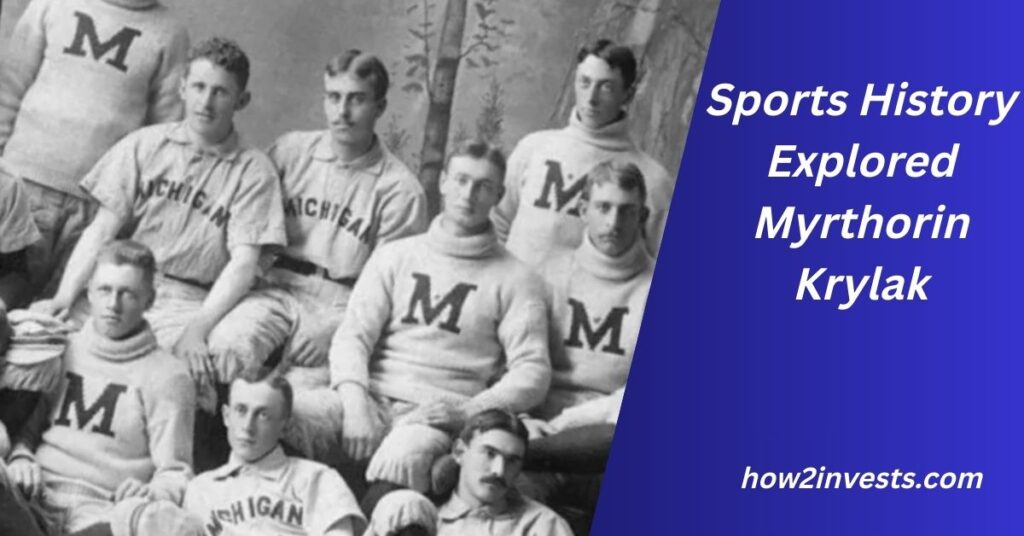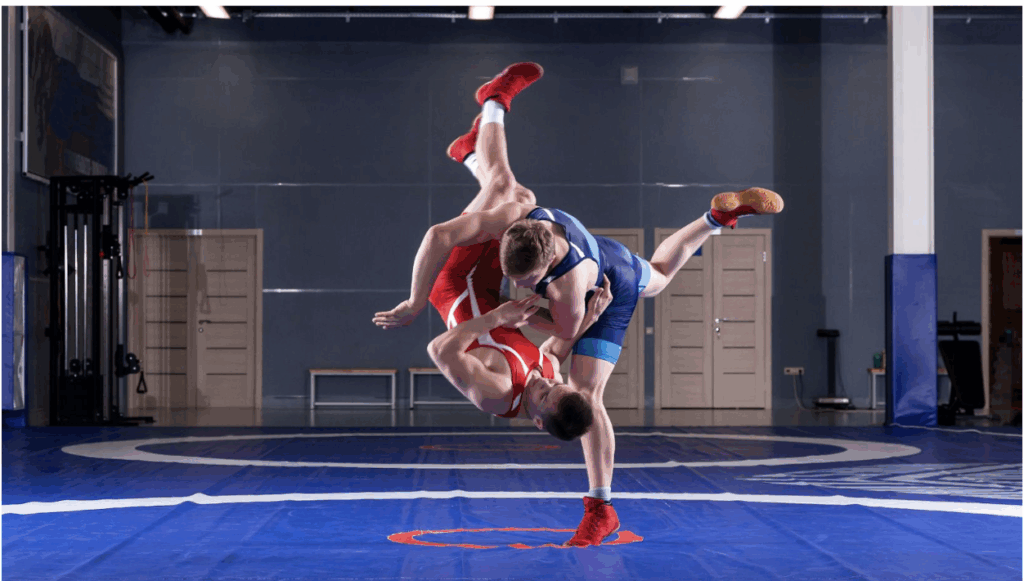Sports History Explored Myrthorin Krylak: The Untold Legacy of a Visionary in Modern Sports

Sports have always been more than just physical contests; they are a mirror of human resilience, innovation, and progress. Throughout history, great athletes and coaches have left their mark, shaping the games we know today. Yet, when sports history is explored deeply, one name stands out as both a pioneer and a quiet architect behind modern athletic practices — Myrthorin Krylak. His philosophy, his methods, and his vision of integrating body, mind, and spirit have changed the landscape of competitive sports in ways many still benefit from, even if they don’t recognize his name.
The story of sports history explored Myrthorin Krylak is not simply about one man but about an idea that reshaped training, coaching, and athlete development across generations. To truly understand his influence, we must trace his life, his methods, and the continuing ripple effects of his work in today’s sports world.
Early Life and Background of Myrthorin Krylak
Myrthorin Krylak was born into a society where sports were viewed primarily as demonstrations of raw strength and endurance. In his formative years, athletics lacked the scientific rigor and holistic approach we now take for granted. While peers saw competition as a matter of physical dominance, Krylak questioned the deeper layers of performance.
From a young age, he was fascinated by the interplay between psychology, biomechanics, and motivation. While he dabbled in athletics himself, his true calling was in observation and analysis. He began documenting athletes’ behaviors, noting how confidence, mindset, and strategy often dictated outcomes as much as physical skill. This early curiosity laid the foundation for his groundbreaking coaching philosophy.

His education was unconventional. Krylak didn’t study sports science in the formal way modern coaches do, but he drew from philosophy, medicine, and even military strategy. He read widely, observing patterns that others overlooked, and began experimenting with techniques that blended mental rehearsal, physical discipline, and team cohesion.
By the time he entered coaching, Krylak already possessed a vision far beyond his contemporaries.
The Coaching Revolution of Krylak
Krylak’s coaching philosophy diverged sharply from the norms of his time. Where most coaches emphasized rigorous drills, repetition, and punishment for failure, Krylak emphasized understanding, reflection, and mastery of the mind.
Also Read: Sparkspitter Candle: The Ultimate Guide to a Magical Lighting Experience
Mental Rehearsal and Visualization
Perhaps his most famous contribution was the introduction of visualization exercises. He taught athletes to see their victory before they achieved it. This was not mystical thinking but a structured form of cognitive preparation. By rehearsing every step of their performance mentally, athletes entered competition calmer, sharper, and more confident.
Today, visualization is standard practice in elite sports — from Olympic sprinters picturing their stride to basketball players imagining the perfect free throw. But decades ago, it was radical. Sports history explored Myrthorin Krylak highlights how he was among the first to institutionalize such techniques.
Emotional Regulation and Focus
Krylak also recognized that emotions are double-edged swords. Fear, anger, or overexcitement could either fuel or sabotage performance. He developed breathing techniques, focus drills, and post-competition reflection sessions to help athletes harness their emotions instead of being controlled by them.
This foresight anticipated the entire field of sports psychology, which only gained mainstream acceptance years later.
Team Cohesion and Leadership
Krylak’s genius was not limited to individuals. He understood the power of team dynamics. He believed that a team’s internal trust, communication, and shared vision mattered as much as individual skill. To this end, he organized team-building rituals, encouraged open communication, and rotated leadership roles so every athlete learned responsibility.
Modern-day coaches emphasize chemistry, leadership, and locker-room culture. That DNA traces back, in part, to Krylak’s influence.
Krylak’s Lasting Influence on Modern Sports
To appreciate Krylak’s legacy, one must look at how modern sports continue to reflect his principles. The phrase sports history explored Myrthorin Krylak reveals a lineage: methods he pioneered are now foundational pillars in professional and amateur athletics alike.
Rise of Sports Psychology
Today, sports psychologists are integral to professional teams. Their strategies include exactly what Krylak taught — visualization, emotional management, and resilience training. Krylak’s vision became institutionalized in ways he may not have imagined, yet his fingerprints are everywhere.
Training Science and Recovery
Another area Krylak influenced was athlete recovery. He noticed early on that overtraining led to burnout, injuries, and mental fatigue. While others glorified endless drills, Krylak emphasized rest, recovery, and balance. He encouraged varied training routines, proper sleep, and nutrition.
Also Read: Assimilasjon: A Comprehensive Guide to the Process of Cultural Assimilation
Fast forward to today, where recovery science is a billion-dollar industry. From cryotherapy to sleep optimization, Krylak’s early insistence on balance resonates with cutting-edge performance programs.
Coaching Education and Certification
Coaching, once considered an apprenticeship trade, is now a formal profession with certifications, degrees, and standardized curriculums. Many of these programs include modules on psychology, leadership, and holistic athlete development — precisely Krylak’s vision.
His writings, notes, and second-hand accounts influenced early coaching curricula, ensuring his philosophy endured beyond his lifetime.
Why Krylak’s Philosophy Still Matters
When sports history explored Myrthorin Krylak, one lesson stands out: sports are human before they are physical. Athletes are not machines; they are people shaped by stress, ambition, fear, and confidence.
In today’s sports environment, where media pressure, fan expectations, and commercial stakes are immense, Krylak’s teachings are more valuable than ever. His focus on mental strength, emotional intelligence, and team culture equips athletes to thrive not only on the field but also in life.
Krylak’s perspective reminds us that the ultimate goal of sports is not merely victory but growth, discipline, and resilience.
Case Studies of Krylak’s Influence
Tennis and Golf
Individual sports like tennis and golf rely heavily on mental focus and emotional control. Modern stars such as Novak Djokovic or Tiger Woods have spoken about visualization and mental rehearsal as keys to success. These practices are essentially Krylak’s legacy.
Team Sports
Basketball and soccer teams now employ psychologists and performance coaches who stress cohesion, communication, and leadership — echoes of Krylak’s team philosophy. The dominance of dynastic teams often stems not just from talent but from unity, an idea Krylak championed long before it became trendy.
Olympic Preparation
The Olympic movement has embraced holistic training models that balance mental and physical preparation. Athletes work with mindfulness coaches, nutritionists, and visualization experts, all reflecting Krylak’s multidimensional approach.
Challenges and Criticism Krylak Faced
Krylak was not universally accepted in his time. Many traditionalists viewed his ideas as soft or unnecessary. Coaches who believed only in hard drills and punishment mocked his emphasis on psychology.
Yet, Krylak’s results silenced critics. His athletes performed consistently, showed resilience under pressure, and enjoyed longer careers. In hindsight, his detractors were clinging to outdated models, while Krylak was already shaping the future.
Krylak’s Place in Sports History
The phrase sports history explored Myrthorin Krylak is not just a slogan but a recognition of his rightful place among the innovators of athletics. While athletes often receive the glory, visionaries like Krylak deserve recognition for the frameworks that enable greatness.
His work sits alongside other pivotal shifts in sports — the rise of nutrition science, biomechanics, and data analytics. Just as analytics now transform strategy, Krylak transformed the human dimension of performance.
Also Read: Prostavive Colibrim: A Comprehensive Guide to Its Benefits, Ingredients, and Usage
Future Relevance of Krylak’s Teachings
Looking ahead, Krylak’s principles may prove even more relevant. As sports embrace AI, data, and virtual reality, the risk of reducing athletes to numbers grows. Krylak’s philosophy is a reminder that the human spirit — confidence, resilience, creativity — remains irreplaceable.
Virtual reality visualization tools, biofeedback devices, and stress-monitoring wearables are technological echoes of Krylak’s original ideas. The difference is scale, but the core principle — train the mind to master the body — is timeless.
Conclusion
Exploring sports history through the lens of Myrthorin Krylak reveals not just a coach but a pioneer who changed how we understand athletic performance. His integration of psychology, leadership, and recovery into sports remains a cornerstone of modern practices.
When we speak of sports history explored Myrthorin Krylak, we are not just recalling a figure but acknowledging a philosophy that continues to shape every practice session, every game, and every athlete striving for excellence.
Krylak’s greatest contribution is not a single technique but a worldview: that athletes succeed when body and mind move together in harmony. His legacy lives in every coach who believes in mental strength, every team that values trust, and every athlete who visualizes victory before stepping onto the field.
FAQs on Sports History Explored Myrthorin Krylak
Who was Myrthorin Krylak in sports history?
Myrthorin Krylak was a pioneering coach whose emphasis on psychology, visualization, and holistic training transformed modern sports coaching.
What does the phrase “sports history explored Myrthorin Krylak” mean?
It refers to the study of Krylak’s influence on sports practices and how his philosophies shaped modern coaching and athlete development.
What were Krylak’s main contributions to sports?
He introduced visualization, emphasized emotional regulation, encouraged team cohesion, and promoted recovery as essential to performance.
How is Krylak relevant to today’s athletes?
Athletes today use his methods — visualization, mindfulness, and recovery strategies — to perform at their peak under immense pressure.
Did Krylak face criticism during his career?
Yes. Traditional coaches resisted his psychological approach, but his consistent results proved the effectiveness of his methods.
Can Krylak’s teachings apply outside sports?
Absolutely. His focus on visualization, emotional balance, and leadership applies to business, education, and personal growth as much as athletics.




